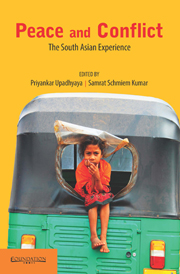Book contents
- Frontmatter
- Contents
- Foreword
- Preface
- Introduction
- 1 Conflict Resolution and Peacebuilding: Ideas, Approaches and Debates
- 2 Changing Perspectives on Peace Studies in South Asia
- 3 Peace Pedagogies in South Asia: Interreligious Understanding
- 4 Responses of Communities to Social Tension
- 5 Plurality of Peace, Non-violence and Peace Works in India
- 6 Education and Culture of Peace: Engaging with Gandhi
- 7 Structural Violence and Human Security: Gandhi's Visions
- 8 Women and the Peace Process in Nepal
- 9 Quest for Peace and Justice in Pakistan: Lawyers' Non-violent Resistance
- 10 Antinomies of Democracy and Peace in Nepal
- 11 Post-armed Conflict Trajectories in Sri Lanka
- 12 Environmental Security and Conflict in Bangladesh: Nature, Complexities and Policies
- Contributors
- Bibliography
- Index
1 - Conflict Resolution and Peacebuilding: Ideas, Approaches and Debates
Published online by Cambridge University Press: 05 October 2014
- Frontmatter
- Contents
- Foreword
- Preface
- Introduction
- 1 Conflict Resolution and Peacebuilding: Ideas, Approaches and Debates
- 2 Changing Perspectives on Peace Studies in South Asia
- 3 Peace Pedagogies in South Asia: Interreligious Understanding
- 4 Responses of Communities to Social Tension
- 5 Plurality of Peace, Non-violence and Peace Works in India
- 6 Education and Culture of Peace: Engaging with Gandhi
- 7 Structural Violence and Human Security: Gandhi's Visions
- 8 Women and the Peace Process in Nepal
- 9 Quest for Peace and Justice in Pakistan: Lawyers' Non-violent Resistance
- 10 Antinomies of Democracy and Peace in Nepal
- 11 Post-armed Conflict Trajectories in Sri Lanka
- 12 Environmental Security and Conflict in Bangladesh: Nature, Complexities and Policies
- Contributors
- Bibliography
- Index
Summary
Introduction
This chapter reviews key ideas and approaches within the field of peace research, from theories of conflict and its causes such as Johan Galtung's conflict triangle and Edward Azar's protracted social conflict, to models of conflict resolution such as John Paul Lederach's conflict transformation theory. Taking stock of major debates in peace research, the chapter also describes the development of a peacebuilding template which has accompanied increasing international and multilateral involvement in conflict resolution worldwide. Consisting of standardized procedures and remedies for post-conflict reconstruction, the peacebuilding template or ‘toolbox’ is built on the premise that conflict-prone societies must be fundamentally re-engineered so as to prevent their relapse into conflict. The chapter discusses debates on the ‘new interventionism’ and its basis in western liberal thinking, which typically advocates institutional reforms to promote ‘good governance’ as a key approach to peacebuilding. Critiques of the ‘Liberal Peace’ paradigm generally fall into one of two broad categories: targeting either problems of inefficiency and strategic deficits, or more fundamental problems with the ideological foundations of ‘liberal peacebuilding’. The peacebuilding efforts of the 1990s were commonly designed to produce measurable gains, favouring efficiency, while contemporary debates on peacebuilding focused on systemic issues such as how to achieve greater coherence and improve output. Scholars of peacebuilding later started to question ‘liberal peacebuilding’ more explicitly, examining the role of liberalization in fuelling conflict, the inherent problems of interventionism and the militarization of peacebuilding.
- Type
- Chapter
- Information
- Peace and ConflictThe South Asian Experience, pp. 1 - 22Publisher: Foundation BooksPrint publication year: 2014
- 1
- Cited by



